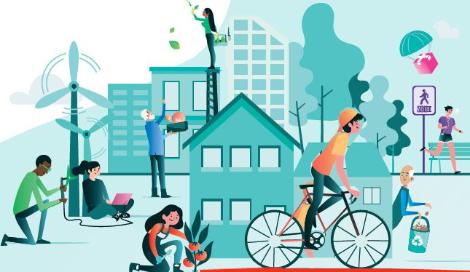Tomorrow my territory 12 Moving differently in my territory
Urban mobility
November 2019
Agence pour l’Environnement et la Maîtrise de l’Energie (ADEME)
The 20 factsheets in the collection « demain MON TERRITOIRE » have been designed to give candidates and elected officials practical keys to take action, to open up the field of possibilities based on the experiences of other elected officials, from small towns to conurbations, large urban areas or sparsely populated areas. In the four corners of France, both in metropolitan France and in the French Overseas Territories, many of them are taking action, together with the players in their territories, to prepare for the future by taking action to mitigate climate change and adapt to its effects. With its knowledge and presence throughout the country, ADEME supports them with its tools, activities and financial aid.

Why is moving differently important?
Traffic jams, noise, pollution… Rethinking travel in urban areas is an emergency. It’s a challenge because we need to change collective and individual habits. Alternatives to the « all-car » contribute to enhancing the image of a community, saving money and improving the quality of life of its inhabitants. They must be attractive and efficient, safe and accessible to all, adapted to everyone - young or old, modest or well-off people.
How do you do it?
-
Active mobility, cycling or walking, is stimulated, with footpaths (benches, lighting, etc.), and cycle-friendly routes. This is complemented by other actions, such as secure bicycle parking, the installation of bollards, the organisation of repair workshops and raising awareness among young people.
-
For more virtuous car journeys, make way for the collaborative. Carpooling in the territory and its suburbs is encouraged by providing a local platform for inhabitants to get in touch with each other and by creating practical and well-marked carpooling areas. Car-sharing is encouraged, with the possibility of renting self-service shared cars, as well as dedicated and/or free parking spaces.
-
Investment is being made in cleaner public transport, with the purchase of low-emission vehicles (electric, hybrid or natural gas). Low-emission shuttles run in the city centre. Developing « high-service buses », which run on a separate lane like trams, and providing park-and-ride facilities at the ends of the line.
-
In the city centre, speed limits are set so as not to endanger cyclists, pedestrians and scooter riders.
-
A transportation-on-demand service (minibuses that take residents to areas not served by regular lines, at the time of their choice) is being introduced to complement the public transit offer.
-
A low-emission zone is set up to prohibit the most polluting vehicles from circulating in the city.
-
The most virtuous behaviours are valued (incentive reward system, promotion of initiatives, etc.).
-
Intermodality is encouraged to enable residents to combine several modes of travel (bicycle + train, scooter + bus…) and make the public transport offer more attractive.
Sources
To go further
30 minutes of walking or cycling per day reduces the risk of diseases (cardiovascular, diabetes, cancer) by 30%. Sce: Public Health France